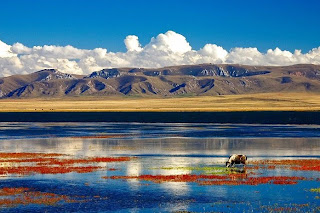Even the most well-meaning field researchers are often guilty of disturbing their study species, since visits to natural habitats involve activity and noise to which the animals would not otherwise be exposed. With a bit of caution, though, the negative impacts of these disturbances can be minimized. In some places, they can even be studied in order to elucidate the long-term impacts of such events.
This was the case at a field site in the Gahai Wetland, China, where collaborators from Lanzhou University were studying black redstarts (Phoenicurus ochruros). These birds nest in clay cavities originally dug into the earth by Tibetan ground tits (Pseudopodoces humilis). Although the original excavations include a small nesting chamber at the end of a long tunnel, the redstarts position their nests somewhere along the tunnel. The distance between the mouth of the tunnel and the nest can be used as an indicator of how worried the redstarts are about predation: If the adults feel that they are in danger, they should put nests closer to the exit in order to hear predators, and effect an escape, sooner; if they fear for their young, they should locate the nests further down the tunnel in order to make it difficult for predators to gain access to the chicks.
(Gahai Lake, China)
The scientists took advantage of these variations in order to investigate whether nesting redstarts responded to the presence of researchers as they would to predators—by shifting the placement of their nests between breeding attempts. This worked because the redstarts have high site fidelity, which means that they return to breed in the same areas in successive years. Thus, the researchers recorded the locations of nests during years when the birds had not been exposed to people during the nesting-building period; if the redstarts found the disturbance from the research project threatening, then when the birds returned to breed during subsequent seasons, they should have positioned their nests differently within the ground tit chambers.
(Black redstart, Phoenicurus ochruros)
Indeed, the proportion of nests at shallow locations (<20.0 cm from the mouth of the tunnel) decreased considerably after the introduction of researcher disturbance. Similarly, the average absolute value of nest depth increased between undisturbed and disturbed years, from approximately 20 cm to almost 40 cm.
The researchers were able to follow six individual females across multiple time points. Each bird responded similarly to exposure to humans: She built her nest at a greater depth the following year. Both of the failed nests recorded during the four-year study were caused by predation, indicating that attacks are a very real threat in this habitat (usually by common ravens, Corvus corax; red-billed choughs, Pyrrhocorax pyrrhocorax; and little owls, Athene noctua). These failures occurred at shallow depths, highlighting the benefit of shifting nests deeper in the chamber in response to nest-threatening disturbance.
(Black redstart nest. The birds will occupy any secondary "cavity"--including those that aren't fully enclosed and are made of anthropogenic materials.)
Prior to disturbance, mid-depth nests were dominant, which suggests that, in general, adults attempt to balance their safety needs with those of their young. The fact that they move their nests deeper in the cavities in response to anthropogenic activities suggests that redstarts view humans as a threat to their young, rather than to themselves. This response to “nonlethal predation” by humans shows that redstarts, like many other species of bird, are impacted even by innocuous human behaviors. It also indicates that at least some birds use previous experience with people to guide decision-making—in this case, at least a year later. Further work will be needed to determine just how long-term avian memory can be, and whether other species’ behaviors are also guided by recollections of unpleasant anthropogenic encounters.
---
Chen, J.-N., Liu, N.-F., Yan, C., and An, B. 2011. Plasticity in nest site selection of black redstart (Phoenicurus ochruros): a response to human disturbance. Journal of Ornithology 152:603-608.
Thanks to the following websites for providing the images used in this post:
http://www.chinawestguide.com/W/HdContentDisp-16-357-20101215-836286.htm
http://www.birdforum.net/opus/Black_Redstart
http://iberianature.com/lucyblog/category/weather/



No comments:
Post a Comment